Surrey League division 1 match played at the Willoughby Arms on 27 November 2023
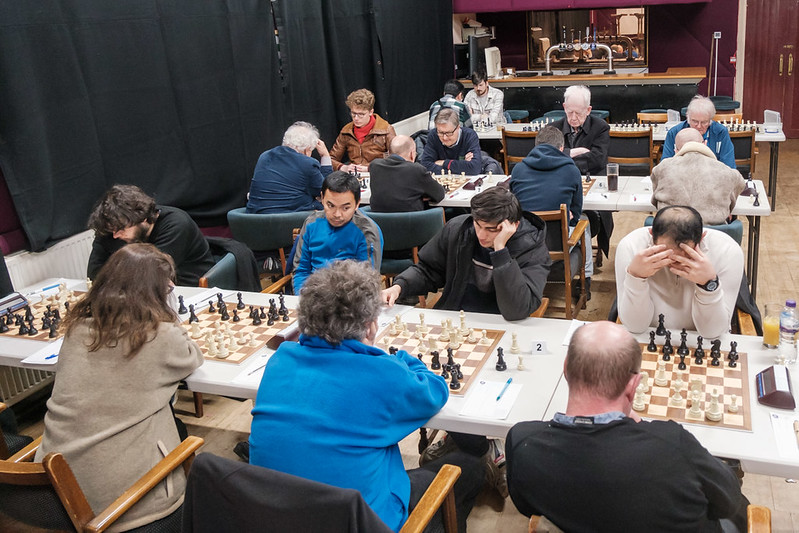
The manoeuvres for this match, between the two highest-rated teams in the Surrey League, began before kick-off. Both sides adjusted their board orders to confuse opposing preparation and avoid specific match-ups. An illness to FM Vladimir Li and a late call-up for IM Ameet Ghasi meant that our team was even harder to guess than Epsom’s. When the names finally hit the teamsheet, we were delighted to find that we had a rating advantage on board 1 and 4 to 8. But that was as good as it got.
One of the first games to finish, on board 8, set the tone. John Foley, who has started the season well, got an edge against Epsom’s energetic president Marcus Gosling, but then inexplicably left a rook en prise. That shock led some others to try too hard to win in our usual crop of time scrambles, rather in the way that a football team 1-0 down in the closing stages is vulnerable to breakaway goals.

David Rowson on board 7, with Black against former Kingston player Chris Wright, defended the English opening with e5 and f5. His position was compact but did not offer many prospects for attack. He had a little work to do to disentangle his pieces, but in this position his choice of 26… Nd4 27. Qd3 Kh8 28. Bxd4 exd4 29. Be6 Rde8 led to simplification and a draw. Interestingly, David’s engine likes Nd4, while Stockfish on my Lichess thinks it is not best and would have preferred Kh8 followed by Bh7. This is an example of the sort of position in which engine lines are not always convincing – various long sequences of moves are possible without the tactical flashes that the machines unerringly spot. David’s solution certainly worked over the board.
Ameet Ghasi on board 1 against IM Peter Large tried a risky-looking sideline in a Bb5 Sicilian to avoid the sort of position with doubled c-pawns seen in a couple of the 2018 World Championship games. Eventually the position converged on something resembling a Kan variation (in which Black plays e6 and a6/b5), but simplified to an objectively level queen and minor piece ending in which Ameet was also well behind on the clock and without much to hit, so a draw could not reasonably be refused.
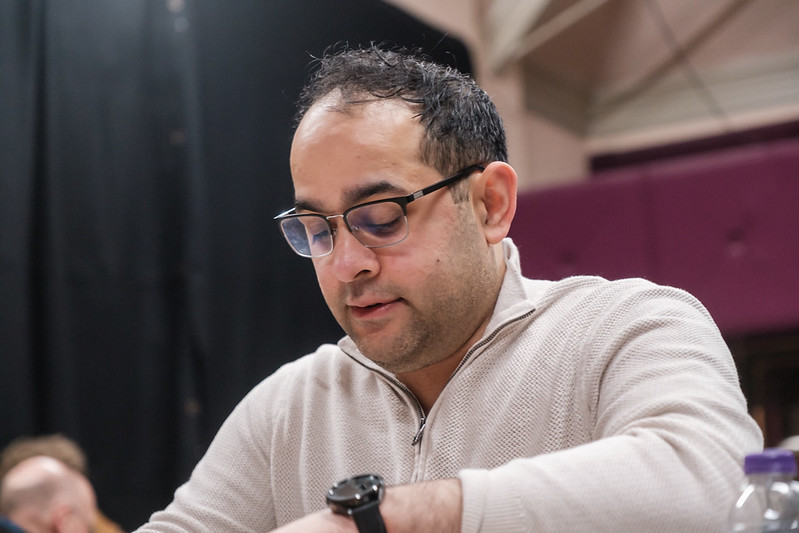
Silverio Abasolo had volunteered to play board 3 against IM and five-times British women’s chess champion Susan Lalić, who played quietly but achieved a permanent squeeze when Silverio was obliged to defend his f7 pawn with a bishop on e8, which in turn needed constant defence. It was the kind of position in which one slip could be fatal. Silverio realised that he had made one and resigned in this position after 25 …. Qb1+. After 26. Kh2 rook anywhere, he cannot prevent Be6. Then if the bishop is taken, White has Qg7 mate, and otherwise f7 collapses.
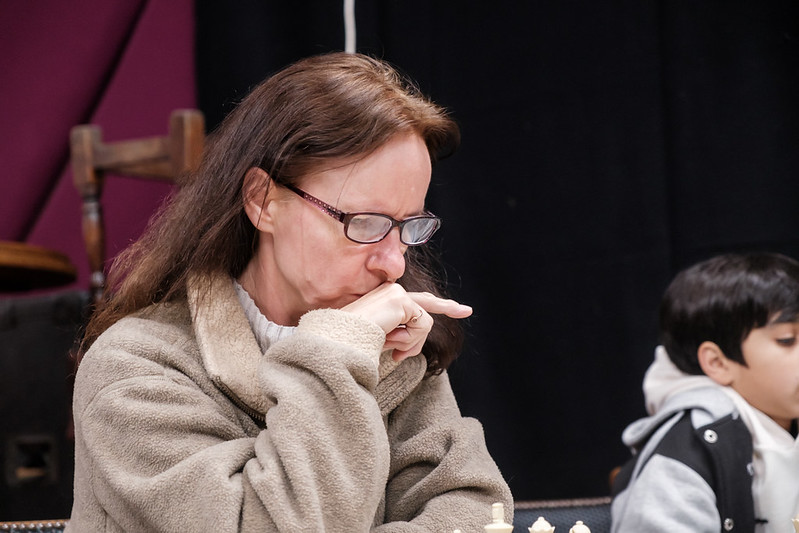
That left the time scrambles. On board 4, Mike Healey had White against Zain Patel, the eighth-ranked under-13 in the country, whose rating has risen more than 500 points in the past two and a half years. The position was blocked for a long time, and I was concerned that Mike might be left with the wrong minor pieces. He broke out of the blockade, but his opponent kept things together well enough to reach a textbook drawn rook and pawn ending a pawn up. Then there was one of those slips explicable only by time pressure and fatigue, and Mike succumbed. A bitter pill to swallow in an ending he has probably taught many times to youngsters like Zain.
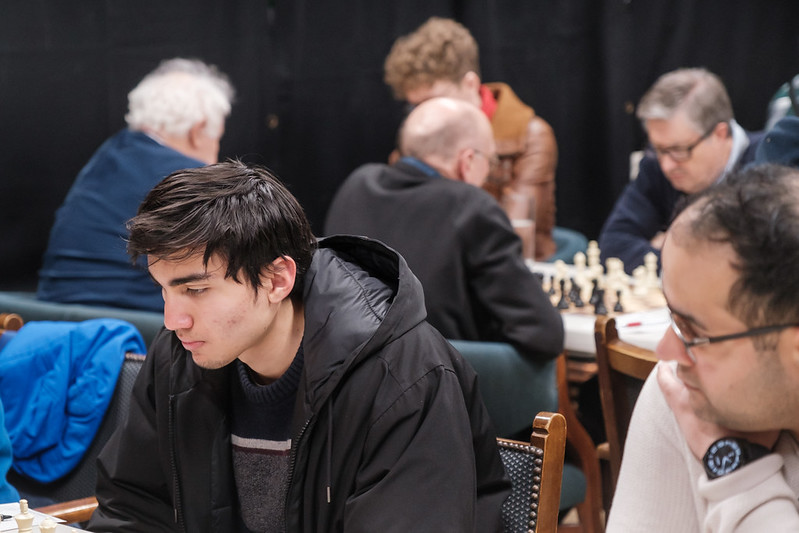
David Maycock on board two against IM Graeme Buckley was aware that the match situation was unfavourable, and pushed hard for the win in a fascinating ending. There were multiple opportunities for both players – in football speak, the “expected goals” for both sides were high. Just to give a flavour of the tricks players at this level can generate, we start with White to play move 30.
Most club players would choose between Bxh4, avoiding the threat of Rg8 forcing the bishop away and winning the g-pawn, or Rxh4, leaving that threat open but countering on the black h-pawn. David found Rf4!, allowing 30….hxg3, but then Rxf7+ and Rxb7 would square up the material with a crushing advantage. The rook cannot be opposed on the seventh and can mop up pawns at will. IM Buckley found the correct defence: 30 … Rf8! 31. Bxh4 f5, but that finesse gave David an edge for a few moves. The next opportunity came on White’s 34th move.
34. Rb6 would eventually have won a pawn here, because the rook on b8 is tied to defending the knight. Play might go 34. Rb6 Rg8 (counter-attack on the g-pawn) 35. g3 a5 36. a4 Rgc8 37. Rb5, and if Black tried to hold all the queenside pawns, White can exploit the weak h-pawn instead. It is quite difficult to judge in positions like this where the defending side is just holding on to all the weaknesses whether it will eventually crack. For many moves, both sides had to evaluate whether Black could take White’s d-pawn, eg after 34. Rc4, the move David actually played. The answer was always no, because after Nxd6 the knight would be pinned and White can always exploit that, in this case with Bxc5.
However, after 34. Rc4 Black was able to wriggle out and counter against White’s own weak pawns. He established an advantage until David spotted a chance here:
Black has defended his h-pawn, but the pin on the e-pawn allowed 45. Rxf4, which should draw. After 45. Rxf4 Rg2+, White has a choice of three king moves. Kd3 and Kc1 are both level. Tragically, Kd1 as played loses, because Rb8 both breaks the pin on the e-pawn, threatening the black rook, and threatens mate by Rb1. A sad end to a very complex endgame.
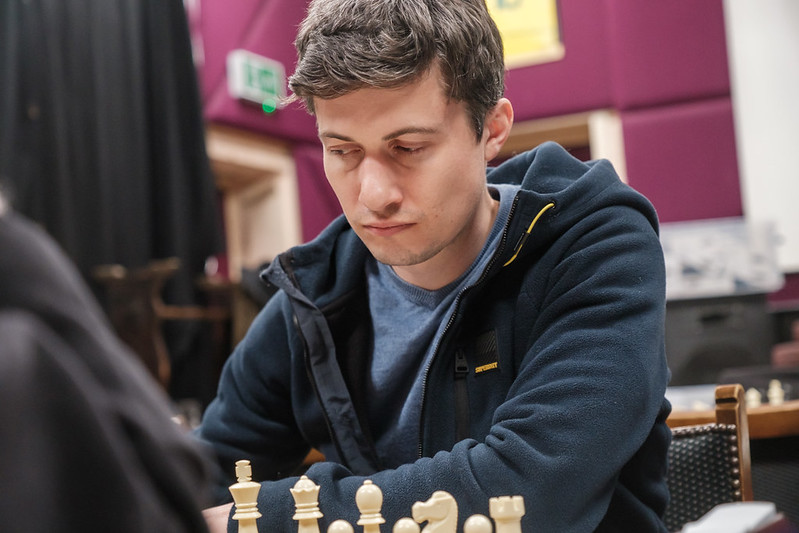
The most exciting game of the evening was the battle on board 6 between Will Taylor and Peter Lee, who won the British championship in 1965. A fuller version with Will’s annotations is in the Games section. Unfortunately Will was only able to record half the game due to extreme time pressure, so we can only enjoy the starter and main course, as it were.
Both sides had already erred in a sharp line in the French when this position was reached after nine moves.
Intending to punish Black’s earlier errors, White now played 10. Bg6, pinning the black queen, and so forcing hxg6. The h-pawn is also pinned, and after 11. Qxh8 White has won the exchange and messed with Black’s pawn structure. But this might have been a punishment that helped the recipient more than the perpetrator. After 11…fxe5, opening up an attack by the queen on White’s knight on f4, and also piling up against d4, Black will get a second pawn for the exchange, with a powerful-looking pawn centre. But his king is stuck in the centre, and he has weak pawns at e6 and g6 which the white knights can arrange to attack. All that made the position difficult to evaluate. At this point the machines think Black stands better, but Will found a logical sequence with his knights which made that assessment look doubtful. This was the critical position.
Black is under pressure, and tries to break out with 19…Nc6, but after 20. Bxf8 Kxf8 21. Nxg6+ White had a material edge as well as active knights, and Black could no longer castle. 19… Rc8 would have been better, although 20. Nh7 would have kept the pressure up. 20…. Rxc3 21. Bd6 Rc6 22. Bxe5 and Black looks horribly bunched up.
Understandably given the complexity of the game from an early stage, Will was unable to record (under the five-minute rule which allows players to stop notating) or remember the second half of the game. Suffice it to say that the position simplified to an ending with two rooks v rook and knight and by then equal pawns, and even playing on the increment for 20-plus moves Will managed to avoid traps and bring home the win.

If that was the 4-3 thriller, Peter Lalić’s board 5 game v Robin Haldane was the equivalent of the 0-0 which is last on Match of the Day (and in this report). Knowing Robin’s love of (metaphorical) bloodshed, Peter went for an exchange of queens on move 4 and a rather dry middle game. This was the position after Black’s move 31, by which time Peter had stopped recording:
Peter’s memory is such that he was nevertheless able to reconstruct the remaining 51 moves in the game, in which not much happened over the board but the players were able to accrue extra time through the 10-second increments. The three-hour playing session ended in this position with Black to play:
Black has won a pawn, but the engines give him an advantage of only 0.6, ie he cannot make a decisive breakthrough. So the game was agreed drawn without the need for adjudication.
Overall a 5.5-2.5 win for Epsom despite being outrated by an average of 100 points per board. A bad one for us, with blunders affecting several boards. But the season is still young. We seized on David Maycock’s Mexican dictum Vivimos para contar otro dia – “We live to tell one more story”. Let’s hope that story is told on 11 March, when we venture to Epsom.
Peter Andrews, Kingston 1 captain in Surrey League division 1

